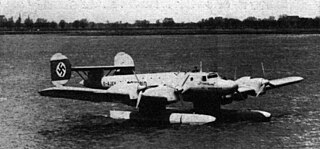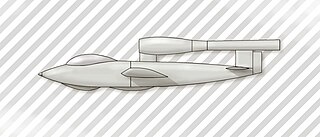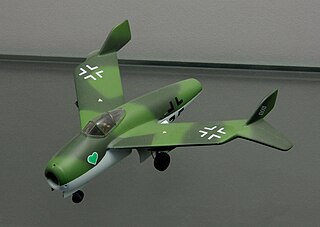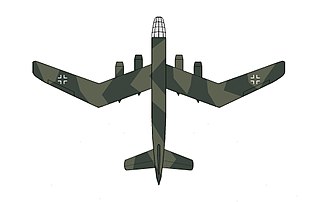
The Blohm & Voss Ha 139 was a German all-metal inverted gull wing floatplane. With its four engines it was at the time one of the largest float-equipped seaplanes that had been built. The inboard engines were mounted at the joint between the inboard anhedral and outboard dihedral wing sections, above the pylon-mounted floats.

The empennage, also known as the tail or tail assembly, is a structure at the rear of an aircraft that provides stability during flight, in a way similar to the feathers on an arrow. The term derives from the French language verb empenner which means "to feather an arrow". Most aircraft feature an empennage incorporating vertical and horizontal stabilising surfaces which stabilise the flight dynamics of yaw and pitch, as well as housing control surfaces.

The Messerschmitt P.1101 was a single-seat, single-jet fighter project of World War II, developed as part of the 15 July 1944 Emergency Fighter Program which sought a second generation of jet fighters for the Third Reich. A prominent feature of the P.1101 prototype was that the sweep angle of the wings could be changed before flight, a feature further developed in later variable-sweep aircraft such as the Bell X-5 and Grumman XF10F Jaguar.

The Blohm & Voss P 194 was a German design for a mixed-power Stuka or ground-attack aircraft and tactical bomber, during World War II.

The Arado Ar 81 was a German prototype dive bomber. Because the Reich Air Ministry decided to purchase the competing Junkers Ju 87, only three prototypes of the Ar 81 were completed.

The Junkers EF 126 was an experimental fighter proposed by the German Miniaturjägerprogramm of 1944–1945, for a cheap and simple fighter powered by a pulsejet engine. No examples were built during the war, but the Soviet Union completed both unpowered and powered prototypes.

The Blohm & Voss P 212 was a proposed jet fighter designed by Blohm & Voss for the Emergency Fighter Program Luftwaffe design competition during the Second World War.

The Blohm & Voss P.208 was a design project for a tailless swept-wing propeller-powered interceptor designed by the German company Blohm & Voss towards the end of the Second World War.

The Blohm & Voss P 213 was a submission to the Miniaturjäger programme of the Luftwaffe Emergency Fighter Program towards the end of the Second World War. The Miniaturjäger was to be powered by a pulse jet but the programme was scrapped in December 1944.

The Messerschmitt P.1110 was a design for a single-seat, high-altitude interceptor, prepared for the German Luftwaffe by the Messerschmitt aircraft manufacturing company, under the Emergency Fighter Program during the last months of World War II.

The Blohm & Voss P 170 was a three-engined unarmed fast bomber and ground-attack aircraft project proposed by the aircraft manufacturer Blohm & Voss to the Luftwaffe during the Second World War.

The Blohm & Voss Bv P 188 was a long-range, heavy jet bomber design project by the Blohm & Voss aircraft manufacturing division during the last years of the Third Reich. It featured a novel W-wing planform with variable incidence.
The Blohm & Voss P 163 was a design project for an unconventional bomber during World War II. Constructed mainly from steel, its crew were accommodated in large wingtip nacelles, giving it a triple-fuselage appearance. Its propeller drive system was also unusual, with the central fuselage containing twin engines coupled to a front-mounted contra-prop.
The Blohm & Voss P 203 was a design project for a heavy fighter during World War II. Capable of filling the roles of night fighter, light bomber and ground-attack, it had mixed propulsion, having both piston engine driven propellers and jet engines.
The Blohm & Voss P 209 was one of a series of single-engined jet fighter design studies. Under development in the latter half of 1944, when the single-engined jet fighter requirement was issued the P 209 was radically revised to meet the deadline but was not taken further by the RLM.
The Blohm & Voss P 196 was the last of Blohm & Voss's World War II design projects for a "stuka" dive bomber and close support aircraft to replace the aging Junkers Ju 87.
The Blohm & Voss P 197 was a design project during World War II for a single-seat twinjet fighter, in response to a requirement issued in 1944.
The Blohm & Voss P 198 was a design project during World War II for a single-seat high-altitude jet fighter.
The Blohm & Voss P 192 was a design study for a dive bomber/ground attack aircraft intended to replace the Junkers Ju 87.
The Blohm & Voss Ae 607 was a jet-powered flying wing design drawn up by Blohm & Voss in 1945. Very little is known about it and its existence was only confirmed in 2017.












